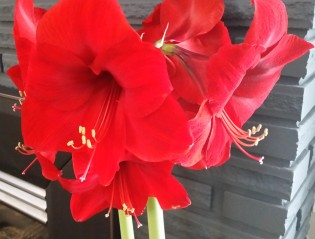Saving beautiful bloomers

( at right, a stunning amaryllis – photo 250news)
With some care and attention, many of the flowering plants that have stopped blooming, can be coaxed to bloom again, following a few easy steps.
African Violets are among some of the favourites when it comes to tropical houseplants. These plants have been loved by many gardeners and given the right conditions can grace you with flowers almost year round.
In order for them to bloom, African Violets need 14 hours of light, which here in Prince George can be difficult, but not impossible. Place them in an East facing window during the seasons of short days, and give additional lighting with a reading light. Always water African Violets from the bottom, never from the top. Place the plant in a sink or tub with some luke warm water and allow it to soak the water up, for a few minutes. African Violets also appreciate humidity, and to increase the humidity of the air around them, place the plant on a water filled pebble tray, remembering to keep the water level just below the surface of the pebbles, so the plants roots is not sitting in water.
Phalaenopsis Orchids are another plant that can bloom almost year round when given the right care. Once your orchid has finished blooming cut off the stem leaving two healthy nodes (these are the little brown lines on the stem, directly below the flowers). One of these nodes will then sprout and usually produce flowers within eight to twelve weeks. If your orchid has not flowered by the end of this time it may need a slight dip in temperature to indicate the lower temperatures of fall. Place it in an area a few degrees cooler for a while and then move it back to its original spot.
Amaryllis bulbs have grown in popularity over the years because they are easy to grow and the flowers are stunning. To get them to re-bloom is actually quite easy. Once the flowers have finished and the main stalk has begun to sag, cut the stalk down to just above the bulb nose. Continue to water and fertilize with 20-20-20 all summer allowing the leaves to fully develop and grow. It can be placed outdoors in a semi shaded area after all risk of frost has passed and then brought back indoors before the first fall frost.
When the leaves begin to yellow in late fall cut them back to 5 cm above the bulb. Place the plant in a cool (7-16C) shaded area in your home for a minimum of 6 weeks, then repot in fresh indoor soil approximately 8 weeks before you would like it to bloom. Move it to a warm, sunny location and water it once, and then not again until growth begins.
An attractive seasonal plant, the Christmas Cactus can be made to re-bloom again and again. Once it has finished blooming, cut back on the watering and allow the plant to dry out slightly as this will signal it to go dormant. Next, your plant needs to go through a cool and dark period. Move it to a cooler room, or a heated garage, where temperatures are around 12-15 C and where it will receive complete darkness at night. Keep the cactus there for approximately 4-6 weeks until buds are formed, then return it to its regular spot and resume regular watering. You cactus should re-bloom multiple times a year, following this pattern.
-Jos
Jos Van Hoge owns and operates two Art Knapp Home and Garden Centres in Prince George:
- Highway 16 west at Kimball Road
- Highway 97 North at Northwood Pulpmill Road ( closed for the season)

Comments
Comments for this article are closed.